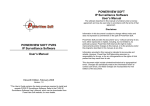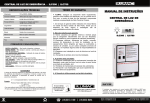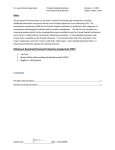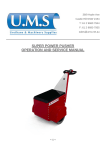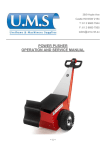Download Solar Heating System User Guide Components of
Transcript
Solar Heating System User Guide Congratulations! You have purchased a solar heating system from 1 World Solar Ltd. We hope that our system will provide you with many years of free hot water. The solar system is expected to provide most of your hot water between April and September, with further solar pre-heat hot water provision throughout the year. On average about 30-70% of annual requirements, depending on collector area and water use. Solar panels to heat domestic hot water have been in use in the UK for over 40 years and a tried and tested technology. Components of the System A solar panel to collect heat from the sun. A pump to circulate water through the solar system. A control unit to of the solar system. A hot water cylinder to store the solar heated water Principles of Operation Your solar system collects and transfers heat using a closed water circuit filled with heat transfer fluid, including antifreeze and corrosion inhibitor The pump is controlled by a differential temperature controller (DTC). When the pump is on water is circulated through the solar panel and collects heat from the sun, which is then transferred to the hot water cylinder via a heat exchange coil. Typically DTC On is at 4C and DTC Off is at 2C. The DTC will also limit the maximum temperature of the hot water cylinder, Tmax according to user preference. Typically 60-80C. In hard water areas it is recommended to limit the maximum solar temperature to 60C limit limescale deposits in the cylinder. Above: A typical solar system with twin coil cylinder. Getting The Most From Your Solar System On clear sunny days you will normally have a full tank of hot water, so these are the best days to do washing or have a bath in the evening for instance. Water in the hot water cylinder will stay hot for more than 48hrs due to insulation on the cylinder. Make sure any boiler connected to the hot water system is set to come on as late as possible in the day. This will top up the solar hot water, if required, and stop fossil fuel energy being used to heat water that could be heated by the sun. It is important to always heat the water to 60C before using it to kill any bacteria which could develop if water is left only lukewarm (26-46C). If a thermostatic mixing valve (TMV) is fitted then Tmax can be set high (e.g. 80C) and then mixed to a safe temperature (e.g. 50C). If no TMV is fitted then set Tmax to a safe temperatue (e.g 60C). Here comes the sun: a field trial of solar water heating systems Findings of the field trial morning lets cold water into the base of the cylinder, which provides a volume of cool water for the solar collector to heat up the next day. Many of the solar water heating systems where the back-up heating was found to be adding heat to the cylinder after hot water use had finished provided less energy overall, as there was less or no cool water for the system to heat. Energy (Wh) Temperature (°C) Energy (Wh) Temperature (°C) Interaction between the timing of water use and use of back-up heating system The timing of the back-up heating system and hot water use has been found to have an impact on how much energy a solar water heating system can provide. Systems that provided more energy were found to time the back-up heating to finish just before the period of higher hot water use and commonly (although not exclusively) at the end of the day. Subsequent use of hot water from the cylinder in the evening or in the Time Time Peak solar irradiation 1,000 W/m2 Peak solar irradiation 1,000 W/m2 Hot water use Solar energy Water use temperature Hot water use Solar energy Water use temperature Boiler heating Solar irradiation Solar temperature Boiler heating Solar irradiation Solar temperature Figure 10. Example of well-timed hot water and back up heating use Figure 11. Example of poorly timed hot water and back-up heating use The boiler fires at 15:30, raises the temperature of the hot water to 62°C for use that evening and the following morning. Although the household does not have a high water use this arrangement makes the maximum volume of cold water available the next day for the solar water heating system to heat. The solar water heating system started operation at 08:00 and had a cool cylinder temperature of 20°C at the bottom. It raised this to about 55°C over the course of the day. The household uses water predominantly in the morning, but the boiler fires between 06:00 and 08:00, during and after hot water use. This ensures that the boiler-heated zone in the cylinder is hot at the start of the day. Although it is a sunny day, solar energy can only be added to the solar dedicated section of the cylinder and the temperature of this smaller volume is rapidly driven up to 60°C by around 12:30. For the rest of the day, although high levels of solar energy remain available until 16:00, there is nowhere to put it and the solar hot water system switches off. 15


